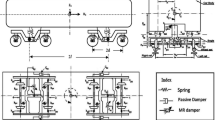Abstract
To suppress vertical flexural vibration of a railway vehicle car body, a new passive control method by mounting dampers on the longitudinal beams of the car body underframe is proposed. The method is firstly studied by an Euler-Bernoulli beam model using Green’s functions, then it is further verified by a nonlinear dynamic model of the vehicle. Results show that the car body flexural vibration can be noticeably reduced by this method. It is better to mount the damper near the car body centre. The higher damping coefficient of the damper, the more effective in decreasing the car body first vertical bending vibration. The higher the rigidity of the damper bracket and rubber bush, the better performance of the damper. It is found that when mounting six dampers at proper positions, the damping coefficient of each damper is 1.33×107 N·s/m, even if the first vertical bending frequency of the studied car body is only 7.2 Hz, a very good ride quality will be achieved when the vehicle runs at 250 km/h.
Similar content being viewed by others
References
J. Zhou et al., Influences of car body vertical flexibility on ride quality of passenger railway vehicles, Proceedings of the Institution of Mechanical Engineers, Part F: Journal of Rail and Rapid Transit, 223 (5) (2009) 461–471.
E. Foo and R. M. Goodall, Active suspension control of flexible-bodied railway vehicles using electro-hydraulic and electro-magnetic actuators, Control Engineering Practice, 8 (5) (2000) 507–518.
D. Gong et al., Vertical ride quality of flexible car body railway vehicles with optimal control, Journal of Tongji University (Natural Science), 39 (3) (2011) 416–425 (in Chinese).
D. Gong, J. Zhou and W. Sun, On the resonant vibration of flexible railway car body and its suppression with DVA, Journal of Vibration and Control, 19 (5) (2013) 649–657.
A. Hechmann and O. Vaculin, Multibody simulation of actively controlled carbody flexibility, Proceedings of the 2002 International Conference on Noise and Vibration Engineering, Leuven, Belgien (2002) 1123–1132.
M. Abu-Hilal, Forced vibration of Euler-Bernoulli beams by means of dynamic Green’s functions, Journal of Sound and Vibration, 267 (2) (2003) 191–207.
M. A. Foda and B. A. Albassam, Vibration confinement in a general beam structure during harmonic excitations, Journal of Sound and Vibration, 295 (3–5) (2006) 491–517.
F. Wang, J. Zhou and L. Ren, Analysis on track spectrum density for dynamic simulations of high-speed vehicles, Journal of China Railway Society, 24 (5) (2002) 21–27 (in Chinese).
V. K. Garg and R. V. Dukkipati, Dynamics of railway vehicle systems, Academic Press, New York, USA (1984).
GB 5599-85: 1985, Railway vehicles-Specification for evaluation the dynamic performance and accreditation test (1985).
P. Carlbom, Combining MBS with FEM for rail vehicle dynamics analysis, Multibody System Dynamics, 6 (3) (2001) 291–300.
D. Gong et al., Analysis of flexible resonant vibration of railway car body and design of equipment suspension parameters, Proceeding of the International Symposium on Dynamics of Vehicles on Roads and Tracks (23rd IAVSD), 19-23 August, Qingdao, China (2013).
R. Schwertassek, O. Wallrapp and A. A. Shabana, Flexible multibody simulation and choice of shape functions, Nonlinear Dynamics, 20 (1999) 361–380.
S. Dietz, H. Netter and D. Sachau, Fatigue life prediction of a railway bogie under dynamic loads through simulation, Vehicle System Dynamics, 29 (3) (1998) 385–402.
Author information
Authors and Affiliations
Corresponding author
Additional information
Recommended by Associate Editor Eung-Soo Shin
Dao Gong, born in 1985, is an Assistant Professor in Institute of Rail and Transit, Tongji University. He has been researching on railway vehicle vibration testing and control.
Jinsong Zhou, born in 1969, is a Professor in Institute of Rail and Transit, Tongji University. He has been researching on railway vehicle dynamics, modal parameter testing and control of vibration and sound of railway vehicles.
Rights and permissions
About this article
Cite this article
Gong, D., Zhou, J. & Sun, W. Passive control of railway vehicle car body flexural vibration by means of underframe dampers. J Mech Sci Technol 31, 555–564 (2017). https://doi.org/10.1007/s12206-017-0108-2
Received:
Revised:
Accepted:
Published:
Issue Date:
DOI: https://doi.org/10.1007/s12206-017-0108-2




